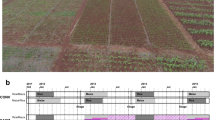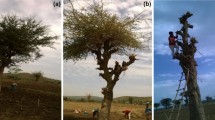Abstract
The aim was to identify biological and physical factors responsible for reducing maize yield in Cameroon. Two surveys were conducted in 137 fields in two agroecological zones in 1995–1997. In the Humid Forest (HF), Bipolaris maydis, Stenocarpella macrospora, Puccinia polysora, Rhizoctonia solani and soil fertility were factors that reduced maize production in 1995 and 1996. In the Western Highlands (WHL), Cercospora zeae-maydis, and the interaction between soil fertility and maize variety were the most important constraints to maize production in 1996. In 1997, C. zeae-maydis, S. macrospora, physiological spot and stem borer damage (Busseola fusca) were negatively related to ear weight. The combination of these biological factors (diseases and insects), and the physical parameter of soil fertility were responsible for reducing maize yield in these selected benchmarks of Cameroon. Maximum potential yield reductions were estimated at 68% due to B. maydis and 46% due to S. macrospora, respectively, in the HF in 1995. In 1996, maximum potential yield reductions in the HF were estimated at 34%, 41% and 30% due to S. macrospora, P. polysora and R. solani, respectively. In the WHL, C. zeae-maydis had the potential to cause a yield reduction of 79% in 1996. In the WHL in 1997, the interaction between C. zeae-maydis and B. fusca, stem diseases and the physiological spot caused potential reductions of 52%, 34% and 39%, respectively.
Similar content being viewed by others
References
Ayuk-Takem AJ (1996) Agricultural research and extension resources. Country: Cameroon. In: Cardwell KF (ed) Proceedings of theWorkshop on Mycotoxins in Food in Africa (pp 44–45) IITA, Cotonou, Benin
Ayuk-Takem JA, Eckebil JP and Chheda HR (1982) Problems and potentials of maize (Zea mays L.) Research and production in Cameroon. Revue Science et Technique 2: 5–16
Cardwell KF, Schulthess F, Ndemah R and Ngoko Z (1997) A systems approach to assess crop health and maize yield losses due to pests and diseases in Cameroon. Agriculture Ecosystem and Environment 65: 33–47
Embrechts J (1978) Détermination et évaluation des régions favourables í la culture du cacaoyer au Sud-Cameroun. Université de Yaoundé (125 pp) Rapport Technique
Fajemisin JM (1985) Maize disease in Africa and their role in the varietal improvement process. In: Bantayehu G (ed) To Feed Ourselves: Proceedings of the First Eastern, Central and Southern Africa Maize Workshop (pp 237–250) Lusaka, Zambia
FAO (1986) Efficient fertilizer use in acid upland soils in the humid tropics. Fertilizer and Plant Nutrition Bulletin 10 (p 59) FAO, Rome, Italy
Flett BC and Van Rensburg JBJ (1992) Effect of Busseola fusca on the incidence of maize ear rot caused by F. moniliforme and Stenocarpella maydis. South African Journal of Plant and Soil 9: 177–179
James WC (1971) A Manual of Assessment Keys for Plants Diseases. No. 1458, APS Press, St. Paul, MN, USA
Kotto-Same J, Woomer PL, Moukam A and Zapfack L (1997) Carbon dynamics in slash-and-burn agriculture and land use alternatives of the Humid Forest zone in Cameroon. Agriculture, Ecosystems and Environment 65: 245–256
Latterell FM and Rossi AE (1983) Gray leaf spot of corn: A disease on the move. Plant Disease 67: 842–847
Marasas WFO (1977) The genus Diplodia. In: Wyllie D and Morehouse LG (eds) Mycotoxic Fungi, Mycotoxins, Mycotoxicoxes: An Encyclopedic Handbook, Vol 1 (pp 119–128) Marcel Dekker, New York, USA
MINAGRI (1996) Rapport annuel des activités du Ministere de l'Agriculture Délégation Provinciale de l'Agriculture du Nord Ouest, Bamenda, Cameroun
NCRE (1994) Annual Report. IITA/USAID Project, Yaounde, Cameroon, 261 pp
Ngoko Z (1994) Maize diseases in the highlands of Cameroon. Technical Bulletin FBMDI 22 pp
Shurtleff MC (ed) (1986) Compendium of Corn Diseases, APS Press, St. Paul, MN, USA
Timti IN (1980) A survey of maize (Zea mays L.) diseases in maize growing areas in Cameroon. Revue Science et Technique 1: 83–89
Van Rensburg JBJ, Walters MC and Giliomee JH (1987) Ecology of the stalk borer, Busseola fusca Fuller (Lep: Noctuidae). Bulletin of Entomology Research 77: 255–269
Ward JMJ, Stromberg EL, Nowell DC and Nutter FW (1999) Gray leaf spot: A disease of global importance in maize production. Plant Disease 83: 884–895
Zadoks CJ and Schein RD (1979) Epidemiology and Plant Disease Management, Oxford University Press, New York, USA
Author information
Authors and Affiliations
Corresponding author
Rights and permissions
About this article
Cite this article
Ngoko, Z., Cardwell, K., Marasas, W. et al. Biological and Physical Constraints on Maize Production in the Humid Forest and Western Highlands of Cameroon. European Journal of Plant Pathology 108, 893–902 (2002). https://doi.org/10.1023/A:1021206028492
Issue Date:
DOI: https://doi.org/10.1023/A:1021206028492




